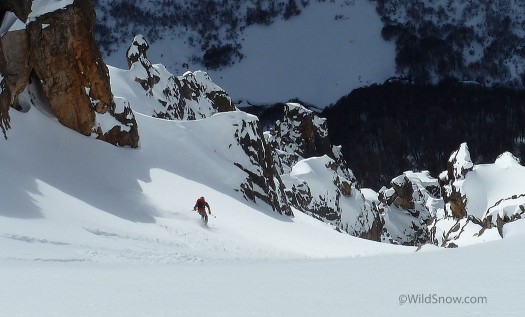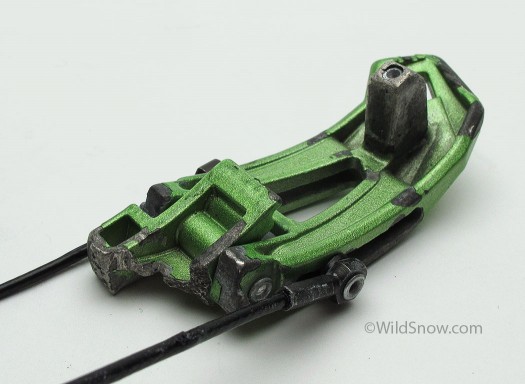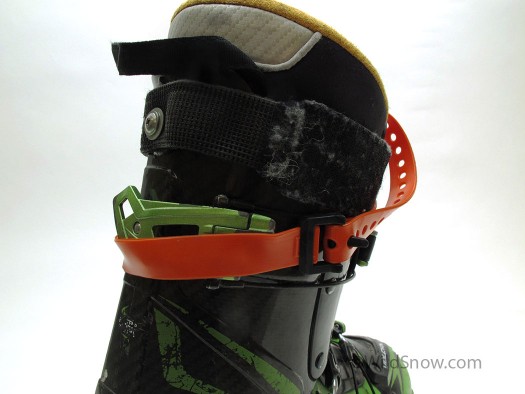In the midst of hectic last-minute packing for South America, a familiarly boot shaped-box quietly showed up on the doorstep. I ripped the package apart like a paper shredder, then stood reverently amid scraps of cardboard, basking in the green glow. Dynafit Vulcans.
Okay, maybe I’m over-dramatizing a bit. However, you can’t ignore the hype surrounding the new crop of ultra light, ultra stiff boots hitting the shelves this winter. They promise to deliver what many skiers have been wanting for a while: a boot that tours great, and approaches alpine-boot stiffness on the down.
The Vulcan backcountry skiing boot features a lower shell constructed of Grilamid, a stiff, lightweight nylon plastic. The upper is constructed largely of carbon fiber, with the very front featuring some plastic. They have three buckles and a removable stiff ski tongue. Vulcan comes with a non-thermo-moldable liner, so I used an Intuition liner instead. I also added a stretchy “booster” power strap (transferred from my Maestrales), and I tied a piece of webbing onto the ski tongues. It’s important to note that the boots I got were pre-production prototypes. Ostensibly the same as production versions, they can have small differences, especially with construction quality. The production versions will have a slightly stiffer flex, and will include a booster strap and thermo-moldable liners. WildSnow.com (hopefully the PNW office), will be testing the full-on production versions as soon as the snow flies.
Here’s the official WildSnow weights for the boots:
Shell, Tongue, and Liner: 1590 grams
Liner: 308 grams
Tongue: 73 grams
I fit most ski boots well, although of all the AT boot brands, Scarpas work the best for my feet. After the first mold, I took the Vulcans out for a test drive on Mt. Baker. In order to evaluate the fit as much as I could, I did the hour-long approach hike in the boots, and then started up the summer snow towards the top. After a few hours the boots hurt so bad I had to take them off. I’ve never had a boot that was that uncomfortable so I was a bit worried.
Back home, I molded the liners once more. This time with a ton of padding on my toes, as well as around my heel to create a larger heel pocket. After the second mold, and a second test drive, the boots still felt mildly uncomfortable, but seemed within the realm of breaking-in. Subsequently they did mold to my feet. I’m not sure why I had the initial fit problem.
Takeaway: when you get your Vulcans, do a good job with the liner molding process and evaluate any super-tight areas that need extra attention during molding. The fit of a boot, of course, is based on your own unique foot shape. On my feet, the Vulcans had a fairly low-volume toe box, as well as a very narrow heel pocket.
I did my best to destroy the Vulcans in South America. They received 35 days of skiing, involving more than a few rock scrambles and dirt hikes. Chilean bus cargo loaders apparently don’t get the bond between a man and his rancid plastic footwear, and did a fair amount of durability testing as well.

Skiing excellent powder in the entrance to one of the Zebra Chutes, near Refugio Frey, Argentina. By the bottom of the run the snow had turned to glop. It was nice to have stiff boots!
First, and most important, how did the Dynafit Vulcan ski? In a word, solid. I skied them with and without the tongues on South American “snow,” everything from grade A powder to horrible ice-chunk nastiness (honestly the worst stuff I’ve ever skied).
Although I skied a fair amount with the ski tongue removed, I felt the Vulcan skied much better with it installed. For some people, the Vulcan is said to be “too stiff.” Not for me. At 150 lbs, I’m a fairly light guy, which is probably why I’ve been able to make do with softer AT boots. Nonetheless, I’ve always wanted more beef. The Vulcans deliver stiffness in a way that’s beyond most AT boots, but they’re still not up to the level of an alpine race plug boot. Once I even felt the Vulcan collapse when I landed a small drop off balance, putting a lot of force on the front of the boot. My heel jammed hard into the back of the boot but I didn’t get shin-bang, something that could have happened with a softer AT boot. Bottom line? Vulcans ski the best of any AT boot I’ve tried, and better than some alpine boots. Again I’ll say it: they ski the BEST of any backcountry skiing boot I’ve tested.
My standard resort boot is a Full-Tilt with the stiffest tongue (#10). Although not a plug boot, they’re stiff in the forward and back flex patterns. The Vulcans aren’t as stiff as my Full-Tilts and don’t ski quite as well, but they are _really_ close. Vulcans have a fairly progressive flex as well, but again, not quite like an alpine boot. Vulcans’ lateral stiffness is impressive, but that’s to be assumed if you look at how rigid the cuff and lower heel area are, as well as how the whole lower part of the boot, being made of Grilamid, resists sideways rolling/twisting of the boot.
(While tech bindings tend to be stiff against rolling force, they only resist boot twisting at the toe attachment so you end up also depending on the boot to resist twisting, instead of the boot heel being nicely clamped down by a binding heel such as that of a Marker Duke.)
At any rate, it’s not that hard to find a boot that skis well. Just clamp your alpine boots in a frame binding if you want proof. But a boot that both walks and skis well, is the perpetual challenge. In that respect the Vulcans could be called a game changer. They are light and the walk mode is impressive. I felt it was equivalent or better to any boot I’ve been in. I opted to do quite a few dirt hikes with the boots, saving the weight of carrying shoes, and they hiked surprisingly well. On some shorter laps I left the ski tongue in for touring, which cut down on the flexibility quite a bit. With the tongue I’d say they tour similar to many “traditional” AT boots; without the tongue they fly.
With the Vulcan design, Dynafit also makes an effort to decrease transition time. In theory, you only need to flip two buckles per boot, and that simultaneously cinches up your foot and locks down the walk mode. However, on laps where you are adding and removing the ski tongue this doesn’t work quite so well. I found that in order to put the tongue in, I had to completely unlatch both the top two buckles — as well as loosen the bottom buckle. To remove the tongue I had to unlatch the top buckle and loosen the bottom two. Doing the tongue swaps was still pretty quick, but don’t expect rando-race transitions, at least when you’re using the ski tongue. More, this system would be problematic for situations such as arctic ski mountaineering in extreme cold.
Vulcans come with three buckles. They are the first boots I’ve had in quite a while that I haven’t felt compelled to pull the bottom buckle off. I skied a bit with the lower buckle loosened, to try it out, and I felt a noticeable difference in how tight my foot was.
The Vulcans ski and walk flawlessly. However, the one area I had issues with was durability. Before I go any further, two caveats about the validity of the durability portion of this review: the boots I tested are pre-production prototypes with perhaps less durability and quality than a production boot (the kind you’ll be buying). Also, when I got them they had already been demoed an unknown amount by various people, contributing to the wear and tear.
About two weeks into our trip, we were scrambling through some rocks to access the entrance of our last couloir on a grand day. After the scramble, we clicked into our skis, and I reached down to tighten my boots. With a loud “snap,” the buckle broke off in my hand. I was able to jury rig something with Voile straps, and we skied pow down to the refugio.

The broken magnesium buckle. You can see it broke where it is made thinner to add the "double hinge" functionality.

Voile straps + simple walk mechanism = easy fix. This is the setup I used for over half my South America trip.
The buckle, while similar to the innovative one used in the TLT 5 series, differs slightly. It features a double hinge mechanism that allows it to fold flatter against the boot. This makes the new buckle more complex, and where the hinge is, it’s thinner. The buckle is long, and sticks out fairly far when you are in walk mode (here’s a quick mod to help that). It’s quite possible that I banged it on a rock moments before it broke. Another consequence of the length is that you can get an obscene amount of leverage, far beyond any other boot I’ve seen. While this leverage is great for getting a tight stiff fit, it might make them more prone to breakage.
Silver lining to the cloud is that Dynafit buckles of the sort on the Vulcan cuff are a super light, solid, and simple mechanism. Such simplicity means they are easy to repair. With a more traditional ski/walk mode switch, you’re hosed if it breaks. When the Vulcan broke, I was able to fix it in a few minutes, and it skied just as good as my other boot. I skied with the fix (a Voile strap) for the rest of the trip, and other than a slightly longer transition time, it wasn’t a big deal.
Vulcans also have a thin, low density sole, both to accommodate the Dynafit easy step in fittings and to save weight. By the end of the trip, the sole was showing serious wear, especially in the toe area. The Vulcans feature 4 posts of hard plastic in the sole that don’t wear down as fast, and support the boot in a frame/plate binding.

Sole wear on the Vulcans. The hard plastic posts are visible as the green circles in the sole in the background.
These boots are light, and that has some side effects. For one, the price, around $1000, is steep. Secondly, every light boot rides a fine line on the edge of durability. Although I had a few issues, the durability wasn’t anything surprising. I’m sure a lot of people will be torture testing these boots this winter, and I’ll be interested to see the results. The Vulcans were a perfect boot for ski travel (besides the $1,000 neon green I-am-a-money-source tourist beacon effect). Having a solid boot, one that I can ski like my alpine boots, and walks as well as a hiking boot is incredible. The Vulcan is possibly the one boot quiver.
Find the Dynafit Vulcan or Dynafit Mercury for sale here. (The Mercury is essentially the Vulcan without carbon cuff.)
Click here to read Lee Lau’s excellent review on the Vulcans, including more detailed fit information, and a few different perspectives.
Louie Dawson earned his Bachelor Degree in Industrial Design from Western Washington University in 2014. When he’s not skiing Mount Baker or somewhere equally as snowy, he’s thinking about new products to make ski mountaineering more fun and safe.

